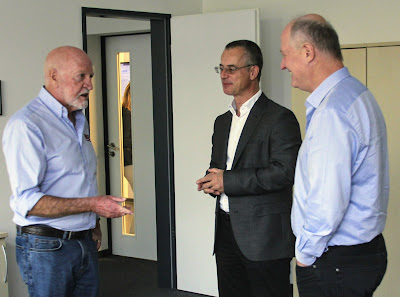Last week I "celebrated" 50 years in the minerals industry. In that half century I have seen enormous changes in mineral processing, both in plant practice and research, so it was perhaps an appropriate time to present a guest lecture at the Helmholtz Institute Freiberg for Resource Technology (HIF) on The Evolution of Mineral Processing.
I had been invited to HIF by Dr. Martin Rudolph, an MEI Rising Star (posting of 12th February 2018), an assistant editor for Minerals Engineering, and head of mineral processing at HIF.
 |
| With Martin Rudolph |
HIF pursues the objective of developing innovative technologies for the economy so that mineral and metalliferous raw materials can be made available and used more efficiently and recycled in an environmentally friendly manner. It was set up in 2011 by the German government as part of its national strategy for raw materials. The founding Director, Prof. Jens Gutzmer, a keynote lecturer at last year's Hi-Tech Metals '18, was joined 4 years later by Prof. Markus Reuter, MEI's consultant to Sustainable Minerals '20, and who has been our consultant in this series since the first sustainable minerals conference, Material, Minerals and Metals Ecology 2006 in Cape Town.
 |
| With Jens Gutzmer and Markus Reuter |
Under the leadership of the two co-directors, and a very impressive team of young researchers, the HIF has rapidly developed into one of the world's premier mineral processing research institutes, equipped with state of the art equipment.
HIF is a constituent part of the Helmholtz-Zentrum Dresden-Rossendorf (HZDR) and works in close collaboration with nearby TU Bergakademie Freiberg, the world's oldest mining university, which was established in 1765. The chemical elements indium (1863) and germanium (1886) were discovered by scientists of Freiberg University.
HZDR is a research laboratory based in Dresden and is member of the Helmholtz Association of German Research Centres. Research is conducted in three of the Helmholtz Association's research areas: matter, health, and energy, of which HIF deals with energy.
During my two days at HIF I met up with members of Martin's team, many of whom are now familiar faces at MEI Conferences, and who regularly publish quality work in Minerals Engineering. Martin alone supervises 12 PhD students, and it was a pleasure to have dinner with some of them after my long first day. Martin and five of his students will be pesenting papers at next month's Flotation '19 and there will be a further 3 representatives from HZDR.
 |
| Dinner in Freiberg with (L-R) Edgar Schach (Germany), Bruno Michaux (Belgium), Martin Rudolph, Anna Vanderbruggen (France), Nathalie Kupka (France), Ahmad Hassanzadeh (Iran) and Duong Hoang (Vietnam) |
Like Cornwall, Freiberg and district has a very rich mining heritage, and like Cornwall, the ore genesis is related to the Variscan Oregeny. Mining around Freiberg has been carried out since the 12th century, initially for silver, followed by tin in the 13th century, copper lead and zinc in the 15th and 16th centuries, cobalt nickel and bismuth in the 18th centuries, and tungsten in the 20th century.
Martin and I visited Altenberg, the most famous tin mine in the region, 45 km from Freiberg and close to the border with the Czech Republic. Now a mining museum, Altenberg ceased production in 1991 after over 550 years continuous operation. One of its claims to fame is that, in 1937, it was the first tin mine in the world to concentrate fine cassiterite by flotation.
I had dinner on my final night in the centre of Dresden with Martin, and Markus Reuter. The beautiful centre was devastated by the Allied bombing raids of February 1945, but reconstruction began after the war and was intensified after German reunification in 1990.
 |
| Dresden 1945. view from the city hall over the destroyed city |
I was last in Dresden in 1991 for the XVIIth IMPC, and one of the social events was a night at the opera at the magnificent reconstructed Semperoper opera house for a performance of the Magic Flute.
 |
| Semperoper in 1991 |
Amidst the still ruined city, the huge mound of rubble which had been the Lutheran Frauenkirche was a particular poignant sight, which had become a symbol of the bombing. In the intervening years, the baroque church, completed in 1743, has been completely rebuilt, and now dominates the skyline much as St. Paul's cathedral does in London.
 |
| The Frauenkirche (X) in 1945, 1991 and 2019 |
The Dresden IMPC was chaired by Prof Heinrich Schubert, who was Director of the TU Bergakademie Freiberg from 1960 to 1991. He was awarded the IMPC Lifetime Achievement Award in 2006 and he died in May last year at the age of 92 (posting of 10th May 2018).
My two days in Saxony were immensely rewarding and interesting and I thank Martin Rudolph and his admirable team for their hospitality. I look forward to seeing him and some of his group in Cape Town next month for Flotation '19.













.jpeg)








Excellent presentation you gave us Dr. Wills, thanks! Very proud to be part of the HIF
ReplyDeleteLucas Pereira, Ph.D. Student at Helmholtz Institute Freiberg for Resource Technology
Freiberg - really interesting location, and can totally agree with Barry the University facilities are excellent. I was there a few years ago with ZincOx and Koppern carrying out briquetting trails.
ReplyDeleteTony Rhymer, Midlands Project Management Services Ltd, UK